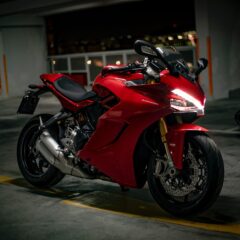
7 Top Motorcycle Accessories
With Christmas just around the corner, you might be wondering what to get your favourite motorcycle enthusiast or even a little something for yoursel...
 Phoenix Motorcycle Training LTD
Phoenix Motorcycle Training LTD
 Phoenix Motorcycle Training LTD
Phoenix Motorcycle Training LTD
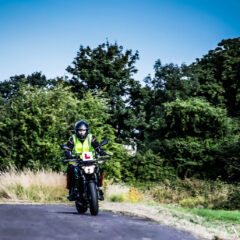
Licences for road users were introduced in the UK way back in 1903. But it wasn’t until 1963 that different motorcycle training courses and tests were introduced for two-wheeled riders.
As safety technology, road use and vehicles have evolved, so have the UK’s motorcycle training courses and laws. It’s this history of developing and updating road and licence rules that’s led to the different paths to a full UK motorcycle licence.
In our guide to motorcycle training courses in the UK you’ll get the low down on all motorcycle licence types and the many paths to getting a full motorcycle licence. That’ll make it easier to choose the best motorcycle training course for your situation.
We kick things off with the different licence types and the restrictions and freedoms they allow.
There are several ways to get on the road with two wheels in the UK. For most people, everything starts with Compulsory Basic Training (CBT). The CBT in the UK is the very first step to riding on your own on public roads.
Only people who got their car licence before February 1st, 2001 and don’t want to ride anything more powerful than 50ccs aren’t required to take a basic motorcycle training course. We recommend moped training anyway. Two-wheeled road users are some of the most vulnerable.
For the rest of us, the UK’s CBT is the first step to two-wheeled freedom.
Just like the name suggests, CBT motorcycle training courses equip new riders with the basic skills for controlling a low-powered motorcycle, moped or scooter. This motorcycle training course doesn’t end with a pass/fail test. Instead, you’ll be coached for a day to develop the necessary skills for road riding. Once you reach this level, you’ll be given a certificate to prove it.
The DL196, commonly known as a CBT certificate, allows you to ride a moped, scooter or motorbike up to 125ccs. You’ll gain the freedom of most public UK roads, but not motorways. You must display an L plate. You’re not to carry a pillion passenger.
CBT certificates are valid for two years. This gives you time to develop your road riding skills and confidence. Before those two years are up, you’ll need to train for a higher level licence or arrange to re-take your CBT course to become recertified. Either choice allows you to continue riding on the road.
The AM licence is for low-powered motorcycles and doesn’t have an expiry date. If you are 16 years old, or older, you’ll be able to take the test for this motorcycle licence. The licence covers motorcycles, mopeds, scooters, and small three and four-wheeled motorcycles (tricycles and quadricycles) up to 50ccs.
You’ll need to have a CBT certificate and pass the motorcycle theory test and both parts of the practical motorcycle riding test — Mod 1 and Mod 2 — to get this licence.
Once you pass these tests, you’re able to ride on public roads without L plates. You can carry a pillion passenger, but you won’t be able to ride on the motorway. The motorway restriction remains because of rule 253 in the highway code. 50cc machines are too slow to be safe on these roads.
The A1 motorcycle licence is for 17-year-olds, or older people who wish to ride a 125cc motorcycle or scooter on public roads. Motorcycle training courses for this UK licence do end with a pass/fail test. Just like the AM licence, you’ll need your CBT certificate and a provisional or full driving licence.
Once you pass the motorcycle theory test, and both Mod 1 and Mod 2 of the practical test on a 125cc motorbike, you’ll be sent a photocard licence. This allows you to ride a 125cc motorcycle or scooter on all public roads, including motorways, without L plates. You can also carry a pillion passenger —as long as you have a seat and footpegs for them.
There is no need to renew this licence with further testing. Some people call the A1 motorcycle licence the ‘permanent CBT licence’. However, if you want to ride a machine more powerful than 125ccs you’ll need a higher-level licence.
You’ll need to be 19 years old, or older, to book a motorcycle training course for an A2 licence. You’ll also need to hold a full or provisional driving licence and have completed your CBT in the UK. Once you gain an A2 licence, there’s no requirement to renew or move up licence levels.
A2 licence training is taken on a 500cc motorcycle or scooter. That lets you become comfortable with the greater power level and higher level of acceleration. Once again, you’ll need to pass your motorcycle theory test, along with Mod 1 and Mod 2 practical tests on a 500cc motorcycle or scooter.
Once you have this licence, you can ride a 35Kw motorbike or scooter (roughly 550ccs to 600ccs depending on the make and model) on the motorway and with a pillion passenger. Of course, you’ll need the right equipment for a second rider but you don’t need L plates. Because there are still power and weight ratio restrictions with this level of licence, it’s sometimes referred to as a ‘restricted motorcycle licence’.
The UK’s A licence for motorcycles is the pinnacle of motorcycle licencing – unrestricted by road use or power-to-weight ratios and available to anyone over the age of 24. If you’ve held an A2 licence for two years from the age of 19, you’ll be able to move to this unrestricted motorcycle licence after your 21st birthday.
Just like the other motorcycle training courses for UK licences, you’ll need to train on a higher-powered bike. At Phoenix Motorcycle Training schools, we train students for A licences on 600cc motorbikes. Once training is complete, you’ll need to pass your theory test and Mod 1 and 2 practical tests. After that, the freedom of two wheels is yours!
There’s no need to display L plates, avoid the motorway, or tell your friends to catch a taxi. You can ride where you like and take a passenger. Just make sure you have the right kit for your friend.
The A licence doesn’t have power-to-weight ratio restrictions, that’s why it’s often referred to as the unrestricted UK motorcycle licence.
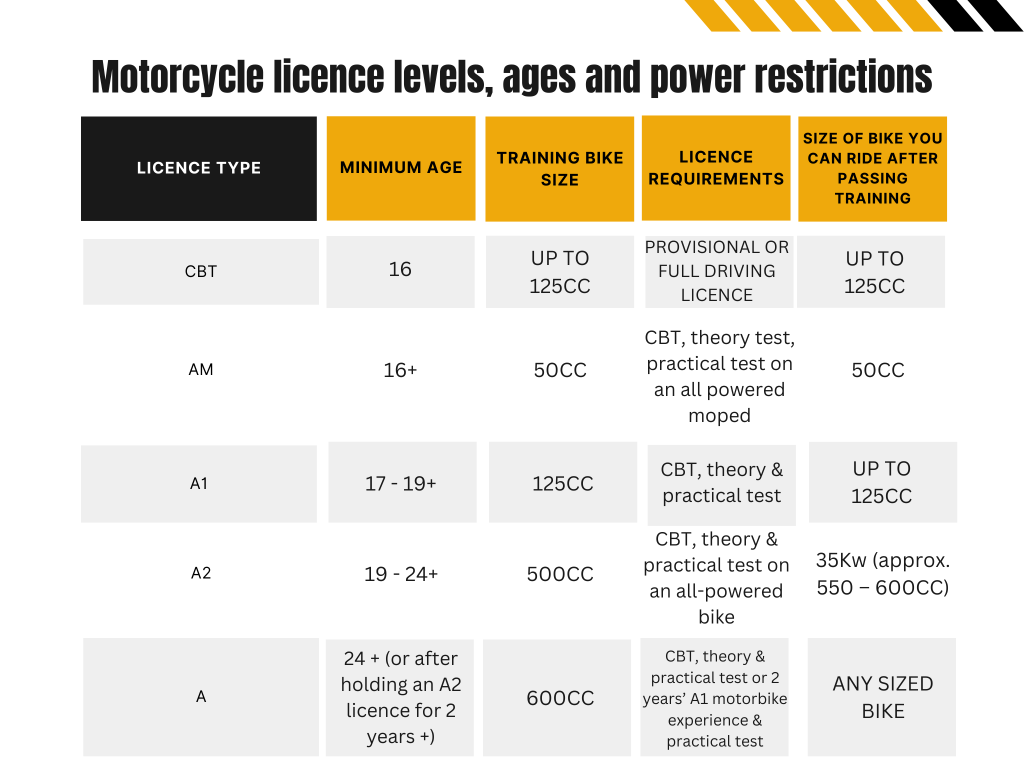
There are a few ways to get a full motorcycle licence in the UK. The progressive route and the Direct Access Scheme (DAS) training are the most common.
There are conditions and caveats to each motorcycle licensing path. That’s because of the way our road and licensing laws have evolved.
The progressive route means working your way through the licence levels as you age.
This route to a full licence starts with a CBT motorcycle training course as early as your 16th birthday. You’ll need your provisional driving licence before booking. Tips for acing your CBT course on your first try include brushing up on your road rule knowledge and being able to ride a bicycle.
Once you have your DL196 or CBT certificate, you’re allowed to practice your skills on the road. You can then choose to take your tests for the AM licence or wait for your 17th birthday to train for your A1 licence. This ‘permanent CBT licence’ won’t expire. It also means you can ditch the L plates. You’ll legally be able to take a passenger and ride on the motorway, but we recommend taking an additional motorcycle training course to learn how to carry pillion passengers and merge onto motorways safely.
After riding with an A1 licence for a few years, the progressive path lets you try for your A2 licence at the age of 19. It’s the same process as training for an A1 licence, but with a higher powered bike. This time, you’ll take a motorcycle training course and test with a 500cc motorcycle or scooter. Once you pass, you can ride a 35Kw bike on any public UK road.
Once you’ve held an A2 licence in your hot little hand for two years, you can repeat the motorcycle training course and test routine for the third and final time. That means you can get a full A licence – the UK’s unrestricted motorcycle licence – as early as 21 when you take the progressive route.
The other benefit of this approach to licensing is moving slowly and steadily up to more powerful motorbikes and scooters. That helps you to gain skill and confidence consistently and thoroughly.
The Direct Access Scheme (DAS) motorcycle training lets riders jump from CBT certification to the highest-powered motorcycle for their age. It’s great for riders who answer their call for two-wheeled freedom a little later in life.
Riders interested in taking DAS training will need to have a valid CBT certificate along with a provisional or full driving licence. When booking your motorcycle training course, let the training school know the level of the licence you are aiming for and your age. This will let them make sure they have the right motorbike or moped ready for you.
New riders can go from CBT to A1, A2 or even a full A licence with DAS training. The testing procedure is the same as the progressive route to a full unrestricted motorcycle licence. The motorcycle theory test, Mod 1 and Mod 2 practical tests need passing on the highest powered motorbike for the licence level.
If you’re a confident and enthusiastic motorbike rider, you could make it your job. Racing and stunt riding aside, motorcycle training course instructors are at the top of their game. It’s a job that’s as fun as it is fulfilling—passing on your skills and enthusiasm to new riders is hugely rewarding.
To go down this career path, you’ll need to be 21 years old, or older. You’ll also need a full driving licence and either an A2 or A motorcycle licence that you’ve held for three years or more. It doesn’t matter if you’ve taken the progressive route or DAS training to reach your licence level.
The first step is to reach out to an approved training body (ATB) to let them know you want to become a motorcycle training instructor. You’ll get a shadow day to make sure this is for you. If it is, you’ll be down-trained by one of their qualified instructors. If you reach out to us, we’ll also support you through the Level 3 AET training. This gives you the skills for training adults and a recognised teaching qualification.
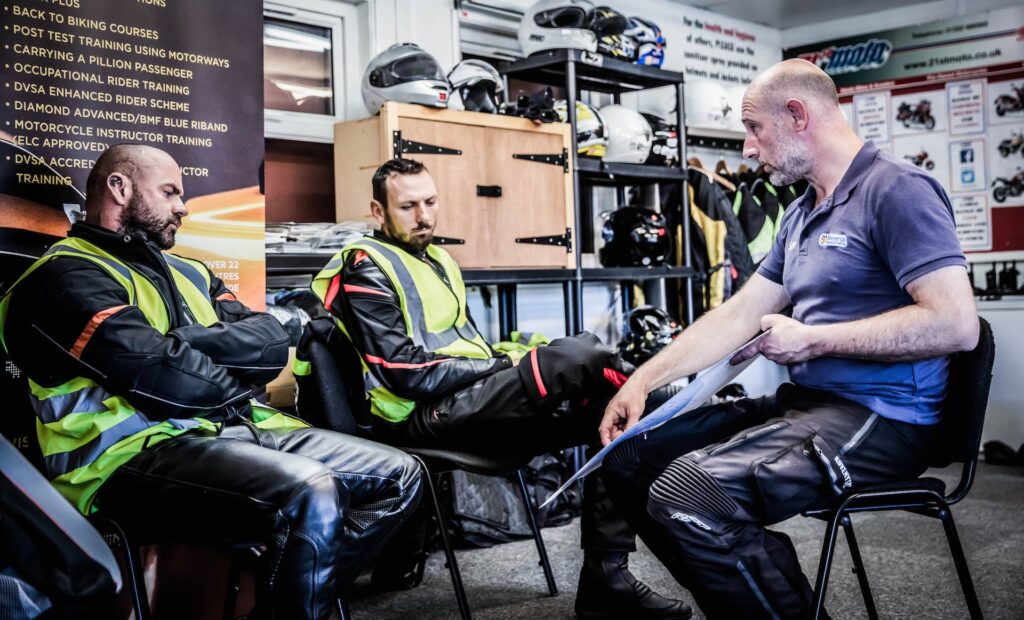
Once you’ve reached the required standard, you’ll be qualified to teach new riders at that motorcycle training school for CBT UK qualifications. To be qualified for teaching the CBT course at any motorcycle training school, you’ll need to take a 2-day training course at a DVSA training and development centre.
To train students for their UK motorcycle licence, you’ll need further training. This step starts with down training from the qualified instructors at your ATB. However, once this training is complete, you won’t be able to take students for motorcycle licence training until you have completed a 1-day training course at a DVSA training and development centre.
You’ll need to meet high standards with ATB down training and DVSA training. That’s because you need to be confident and competent at teaching others to ride safely and to a level that lets students pass their motorcycle licence tests.
Motorcycle training courses in the UK follow a similar structure for all levels and licence types. You’ll begin with theory and rules, move on to practical training away from traffic, and finally put your skills into practice on public roads. This structure lets you build confidence along with competence at a pace that works for you.
Your age when you decide to take to two wheels somewhat dictates the path you’ll tread to the highest level of licence you can get. The progressive route begins with a CBT course, moves on to an AM or A1 licence, skips up to an A2 licence and finishes with a full, unrestricted A licence. You can begin the progressive route to a full A licence as early as 16.
DAS motorcycle training courses also begin with riders getting their CBT certification and then skipping to the highest level licence for their age. If you are 25 years old, or older, this means you can get your CBT certificate and move straight to a full, unrestricted A licence within two years.
CBT courses typically take a day to complete. Sometimes it may be a little shorter, sometimes a little longer. It depends on your experience, confidence and how quickly you pick up new skills.
CBT days are broken into five clear elements:
An introduction to the day: Meet your instructor, check your licence, paperwork and eyesight, and go through the outline of the day. At the end of the introduction, you’ll know how to choose the right equipment and the costs involved.
Practical on-site training: This is your introduction to two wheels. You’ll get familiar with the weight and balance of the motorbike or moped and the controls. You’ll also learn about basic safety checks, starting and stopping the engine, and wheeling and braking the bike.
Practical on-site riding: Now it’s time to get in the hot seat! You’ll practice riding and core motorcycling skills. By the end of this element, observation-signal-manoeuvre (OSM) and position-speed-look (PSL) will feel like second nature.
On-road training: Despite what the name says, this element is back in the classroom. You’ll learn all the information and theory you need to know to understand legal and safe road riding.
Practical on-road training: The final element brings all four previous elements together in a real-world setting. You’ll start on quieter ‘nursery roads’. As you gain confidence and competence your trainer will guide you to larger, faster roads—but only if it’s safe for you and other road users. You’ll stop throughout this element to chat about your manoeuvres, strengths and weaknesses. When your instructor sees you’ve reached a safe level of riding, they’ll guide you back to the training centre and sign off your DL196, CBT certificate.
You can only take DAS training after you’ve got your CBT certificate. There is no minimum period you need to hold your CBT certificate for but you will need to complete your licence training before your CBT runs out. It’s a good idea to leave yourself enough time on your CBT certificate for you to take DAS training and pass both modules of your licence test.
The format for DAS training loosely follows the format of the motorcycle testing structure for licensing. After checking your paperwork and details, your day starts with a confidence ride. This is taken on a motorcycle or moped that matches the power of the bike you’ll be taking your licence test on.
Day one of the training covers the elements you’ll need to show competence in through the Mod 1 test. That covers:
After day one of training, you’ll be taken to your closest DVSA testing centre to take your Mod 1 motorcycle licence test.
The second part of your DAS training covers road riding. Similar to a practical driving test, you’ll ride on the road with a motorcycle of the same power as the licence you are aiming to qualify for. The training covers:
Once this training is complete, you’ll be taken to your closest DVSA testing centre to take your Mod 2 motorcycle licence test.
DAS training is done over two weeks or more, depending on test availability with the DVSA in your area.
Fast-track motorcycle training is very much like DAS training, just condensed into three consecutive days. Your first day focuses on training for Mod 1 skills. Day two covers road riding skills and rules. Your third and final day is when you’ll take both your Mod 1 and Mod 2 tests.
Because fast-track training is condensed, there’s a little more pressure to get things right faster. You’ll need to take an assessment ride before booking this test. This allows your instructor to estimate whether you’ll be able to pass Mod 1 and 2 on the same day after training with them.
This is important because Mod 2 of the motorcycle licence test can’t be attempted unless you pass Mod 1. If you fail Mod 1, you must wait a minimum of three days before trying again.
The only protective gear you legally need to wear when riding a motorcycle is a helmet meeting British safety standards and showing the BSI Kitemate. But that’s not to say a helmet is the only essential piece of safety gear you need to wear. A motorcycle jacket, gloves, and boots take care of all the body parts you need to live a long and active life.
Sharp motorcycle helmet ratings make choosing the best lid for your circumstances and budget easy. Some one-star helmets still meet the UK’s legal requirements. Investing in a sturdy helmet is wise. They don’t just protect you in an accident (although that’s a massive plus), they cancel wind noise, keep you dry and help you see the road ahead clearly.
Rule 84 of the Highway Code recommends riders wear strong boots, gloves and suitable clothing for riding a motorcycle. Boots are almost as important as your lid. Leg and knee injuries are some of the most common in accidents involving riders. A good pair of motorcycle boots will have armoured toes, be made of abrasion-resistant materials and protect your ankles from twists and breaks.
Suitable clothing for motorcycle riding must include a well-ventilated but abrasion-resistant jacket too. There is a huge range of styles and materials to choose from. Look for something that fits well, is protective from weather and impact, and is comfortable to wear.
Gloves are the other essential (if not legally required) piece of clothing we highly recommend. Your hands bear the brunt of the cold, wind, rain and debris kicked up on the road. You need them to grip and control your motorcycle properly – not to mention all the other things they do for you each day! Look for sturdy gloves with armour on the knuckles and fingertips to keep your hands safe and warm.
Quality motorcycle gear isn’t cheap, but it’s worth the investment. Particularly when you consider what it is you’re protecting. You only get one body, best take care of it.
Once you’ve decided to get a UK motorcycle licence, the next step is finding a motorcycle training course in the UK near you. When looking for an approved motorcycle training school, consider the following:
Finding out what past students think of the motorcycle training school you’re considering booking a call with is important.
Online Reputation: Finding out what people are saying online about a motorcycle training course is a great first step. Check review platforms like Google and Trustpilot to see what past students have said about the training school.
Word of mouth: Chat with friends and family who have a motorcycle licence. Ask them about their motorcycle training course and what made it helpful as well as what they didn’t like. This will give you tips on things to look for and schools to avoid.
Each motorcycle training school prices courses differently. Some offer everything you need, others charge extra for insurance, petrol or safety gear.
Comprehensive motorcycle training packages: Look for a training school that offers the complete package. That includes theory and practical training along with all the equipment you’ll need to learn how to ride a motorcycle safely.
Cost-effective training: Some lower-priced training packages don’t include petrol, rider insurance or safety equipment. Instead, you’ll be charged for those on the day. Look for a school that includes everything you need. Value-added items like helmets, motorcycle gear, and insurance make your training cost-effective.
Our course costs include everything students need to learn to ride on the road. We also partner with specialist suppliers of motorcycle clothing, bikes and security products to give our students discounts. This means you’ll be able to get everything you need for less!
Everyone has preferred learning styles and we all learn at our own pace. Some of us are visual learners, others learn better from listening and some of us prefer practical activities.
Individualised attention: A great motorcycle training instructor will adapt their training style to your learning style. Your motorcycle training course will be taken with just one or two others so you get the attention you need to progress quickly through each element at a pace that suits you.
Experienced instructors: Qualified and experienced instructors are a must when you’re learning new skills. New riders gain confidence and competence faster when they are led by experienced, friendly, and knowledgeable instructors. All of our motorcycle training instructors are DVSA-qualified and have recognised qualifications for adult education and training.
Are you ready to begin your motorcycle journey? Book your motorcycle training course with Phoenix Motorcycle Training. We’re the UK’s largest and most respected motorcycle training company. We’re regularly given 5-star ratings from past students who’ve gained their CBT certification or UK motorcycle licence after training with us. Whichever path to a full licence you’re planning to take, we’re ready to help you achieve your riding goals and hit the road with confidence!

With Christmas just around the corner, you might be wondering what to get your favourite motorcycle enthusiast or even a little something for yoursel...
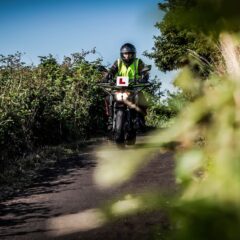
If you love motorcycle riding, you’ve probably daydreamed about riding a motorbike for a living. A professional racer or stunt rider is OK for some...
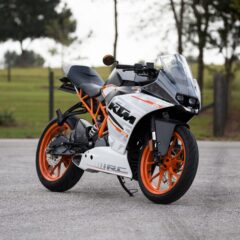
Getting a UK motorcycle licence can seem a complicated process. Particularly when compared to a driving licence for a car. Whether you choose the pro...
This website uses cookies to personalise content, ads, and analyse traffic, sharing data with partners who may combine it with other information. See our Privacy Policy for more information.